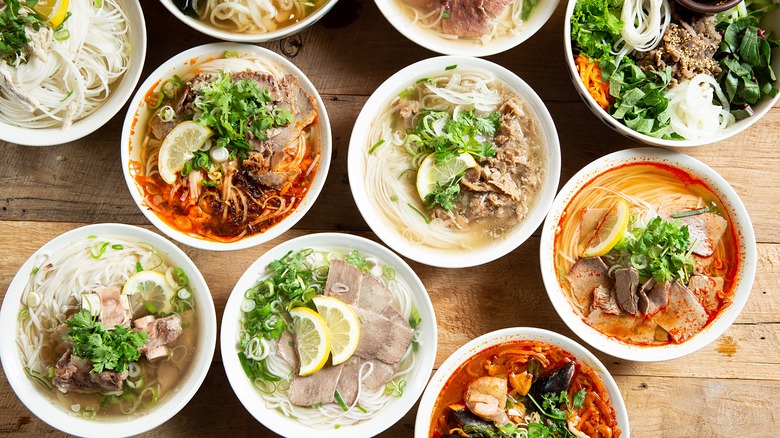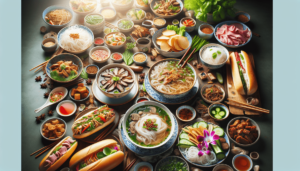If you’re a food enthusiast with a penchant for exploring new flavors, then chances are you’ve heard of pho. This beloved Vietnamese dish has gained worldwide popularity for its complex flavors and comforting qualities. But have you ever wondered what pho can be compared to? It’s like a warm hug on a chilly winter day, a symphony of flavors in a single bowl. Its fragrant broth, tender noodles, and savory toppings create a culinary experience that is truly unique. So, if you’re looking to satisfy your craving for pho, head over to Eurasian Bistro in Pensacola for an authentic and delicious dining experience.

This image is property of static.blog.bolt.eu.
Understanding Pho
Pho is a traditional Vietnamese dish that has gained immense popularity all around the world. It is a flavorful and aromatic soup consisting of a clear broth, tender rice noodles, and a variety of toppings such as thinly sliced beef or chicken, herbs, bean sprouts, and lime. Understanding the composition and significance of pho in Vietnamese cuisine is key to appreciating its unique flavors and cultural importance.
Vietnam’s traditional pho composition
The composition of traditional pho starts with the broth, which is the foundation of the dish. The broth is typically made by simmering beef bones, charred onions, ginger, and a combination of aromatic spices for several hours. This slow cooking process extracts all the rich flavors and releases them into the clear and fragrant broth.
Once the broth is ready, it is strained to remove any impurities, creating a smooth and delicately flavored base. Rice noodles are then added to the broth and cooked until tender. The noodles absorb the savory flavors of the broth, creating a harmonious combination.
To complete the dish, various toppings are added. Thinly sliced beef or chicken, fresh herbs like Thai basil and cilantro, bean sprouts, lime wedges, and sometimes even chili peppers provide additional flavors and textures. The result is a bowl of pho that is both satisfying and refreshing.
Significance of pho in Vietnamese cuisine
Pho holds great significance in Vietnamese cuisine and culture. It is often enjoyed as a hearty breakfast or a comforting meal at any time of the day. Pho restaurants, known as “pho 24” or “pho 48,” can be found in almost every corner of Vietnam, showcasing the deep-rooted love for this dish.
Pho is not just a soup; it represents Vietnamese culinary traditions and history. It is a symbol of community and togetherness, as it is often enjoyed with friends and family around a communal table. The aromatic broth, the mix of fresh herbs, and the tender noodles create a delightful sensory experience that resonates with the Vietnamese people.
Pho and Ramen
When comparing pho to other popular soups from different parts of the world, one that often comes to mind is ramen. Both pho and ramen have their own unique characteristics and cultural significance, making them fascinating subjects of comparison.
Comparing the broth
The broth is a crucial component that sets pho and ramen apart. Pho broth is clear, light, and delicately flavored, allowing the other ingredients to shine. On the other hand, ramen broth is often rich and thick, thanks to the long hours of simmering bones, vegetables, and various seasonings.
Pho broth is typically made with beef, while ramen broth can be made with pork, chicken, or even fish. The unique blend of ingredients and cooking techniques used in each broth results in distinct flavors and textures that characterize these soups.
Differences in ingredients and toppings
Pho and ramen also differ in terms of the ingredients and toppings used. Pho commonly features thinly sliced beef or chicken, while ramen often includes chashu (braised pork), marinated eggs, nori (seaweed), and various vegetables. Each topping in both dishes contributes its own distinct flavors, adding depth and complexity to the overall taste.
Additionally, the noodles in pho and ramen differ in shape and texture. Pho noodles are typically flat and smooth, while ramen noodles are curly and have a chewy texture. These variations in ingredients and toppings give pho and ramen their own unique identities and make them beloved soups in their respective cultures.
Cultural significance of ramen in Japan compared to pho in Vietnam
Ramen holds a significant place in Japanese cuisine and is deeply ingrained in Japanese culture. It is often enjoyed as a quick and satisfying meal, with numerous ramen shops lining the streets of Japan. Ramen is a culinary art form that has different regional variations, each with its own distinct flavors and styles.
Similarly, pho has a profound cultural significance in Vietnam. It reflects the history and diversity of Vietnamese cuisine and is considered a national dish. Pho has become a symbol of Vietnamese identity and is recognized worldwide for its unique flavors and comforting qualities.
While ramen and pho may have some similarities, they also have distinct attributes that differentiate them. Both soups offer a delightful culinary experience that reflects the rich cultures they belong to.
Pho and Miso Soup
Exploring the comparisons between pho and other soups leads us to another intriguing comparison with miso soup. Miso soup is a traditional Japanese staple known for its simplicity and umami-rich flavors. Examining the contrasts in their preparation, cooking times, and flavor profiles provides us with a deeper understanding of these two distinct soups.
Understanding miso soup – a Japanese staple
Miso soup is a simple and nourishing soup made from dashi, a traditional Japanese stock, and miso paste, a fermented soybean paste. The soup is typically seasoned with ingredients such as tofu, seaweed, green onions, and sometimes mushrooms or vegetables.
The preparation of miso soup involves dissolving miso paste in dashi stock, which is made by steeping kombu (kelp) and dried bonito flakes in water. This process infuses the soup with a unique umami flavor that is characteristic of Japanese cuisine.
Contrasts in the preparation & cooking times
In contrast to the slow and labor-intensive process of making pho broth, miso soup can be prepared quickly and easily. The dashi stock and miso paste are combined, gently heated, and then brought to a simmer. The soup is ready in a matter of minutes, making it a convenient and comforting option for a quick meal or side dish.
The cooking times for pho and miso soup also differ significantly. Pho broth requires several hours of simmering to extract the flavors from the bones and spices, while miso soup can be prepared in a fraction of that time. This stark contrast in cooking times reflects the varying culinary traditions and approaches to soup-making in Vietnam and Japan.
How their flavor profiles differ
Pho and miso soup have distinct flavor profiles that set them apart. Pho is known for its light yet aromatic broth, while miso soup showcases the umami-rich flavors of miso paste and dashi stock. The combination of the miso paste with the other ingredients contributes to a deeper and more savory taste in miso soup.
While both soups offer warmth and nourishment, pho and miso soup have their own unique qualities that cater to different taste preferences. The delicate flavors of pho and the comforting umami notes of miso soup make them beloved choices in Vietnamese and Japanese cuisine, respectively.
Pho vs. Tom Yum Soup
Another intriguing comparison can be made between pho and Tom Yum soup, a signature dish in Thai cuisine known for its bold and spicy flavors. Examining the spicy flavor profile and distinct ingredients used in Tom Yum soup sheds light on its differences from pho.
The spicy flavor profile of Tom Yum
Tom Yum soup is characterized by its invigorating blend of spicy, sour, and aromatic flavors. It typically consists of lemongrass, galangal, kaffir lime leaves, chili peppers, lime juice, and fish sauce. The combination of these ingredients creates a fiery and tangy soup that tantalizes the taste buds.
In contrast, pho is not traditionally spicy. The focus of pho is more on the aromatic and savory flavors of the broth, allowing the other ingredients to shine. However, it is worth noting that some variations of pho may include chili peppers or hot sauce, providing a subtle heat to the dish.
Ingredients used in Tom Yum that set it apart from pho
Tom Yum soup stands out from pho due to its use of specific ingredients unique to Thai cuisine. Lemongrass, galangal, and kaffir lime leaves are essential components of Tom Yum, infusing the soup with their zesty and citrusy flavors. The combination of these ingredients, along with chili peppers and lime juice, creates a vibrant and intense taste experience.
On the other hand, pho incorporates ingredients such as star anise, cinnamon, cloves, and ginger, which impart a warming and aromatic quality to the broth. The flavor profile of pho is more subtle and nuanced, allowing the natural flavors of the ingredients to shine through.
The differences between Tom Yum soup and pho highlight the diverse culinary traditions and flavor profiles found in Southeast Asian cuisine. Both soups offer a unique and enjoyable culinary experience, catering to those who appreciate either subtle and fragrant flavors or bold and spicy sensations.
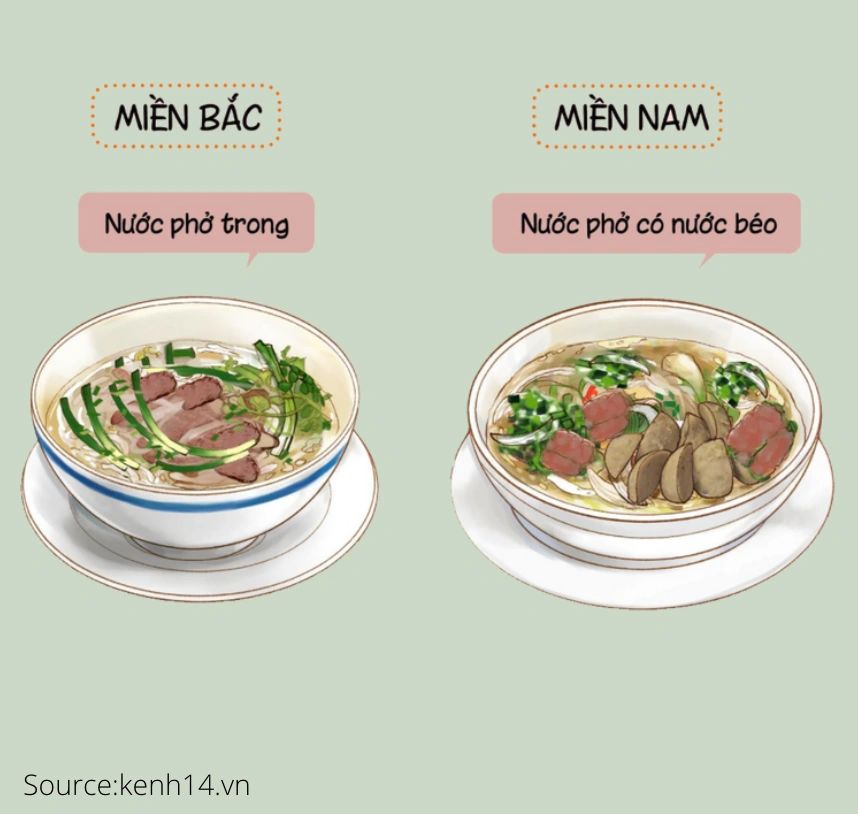
This image is property of img1.wsimg.com.
Pho and Tortilla Soup
While pho has its roots in Vietnam and Tom Yum soup hails from Thailand, another fascinating comparison can be made between pho and Tortilla soup, a Mexican staple known for its rich and comforting flavors. Examining the preparations, flavors, and ingredients of these two soups allows us to appreciate the distinct characteristics of each.
The Mexican staple Tortilla soup
Tortilla soup is a classic Mexican dish that showcases the vibrant flavors of Mexican cuisine. The soup typically consists of a tomato-based broth, tortilla strips, onions, garlic, chili peppers, and a variety of toppings such as avocado, cheese, and lime wedges. The combination of these ingredients results in a hearty and flavorful soup.
Comparison between Pho’s and Tortilla Soup’s preparations
The preparation methods for pho and Tortilla soup differ significantly. Pho requires hours of simmering to extract the flavors from the bones and spices, while Tortilla soup can be prepared relatively quickly. The tomato-based broth in Tortilla soup is often cooked with onions, garlic, and chili peppers, infusing the soup with a rich and tangy flavor.
Pho is traditionally prepared with beef bones, while Tortilla soup can be made with chicken or vegetable broth. The choice of protein adds depth and character to each soup, further enhancing their unique flavors.
Analyzing the flavor and ingredients differences
The flavor profiles of pho and Tortilla soup highlight their distinct cultural backgrounds. Pho boasts a delicate and aromatic broth that is complemented by the freshness of herbs, bean sprouts, and lime. In contrast, Tortilla soup offers a robust and tangy flavor, with the seasoning of cumin, Mexican oregano, and chili peppers providing a spicy kick.
Ingredients such as tortilla strips, avocado, and lime wedges are key components in Tortilla soup that add a textural contrast and bright citrusy notes. These ingredients, along with the option to add cheese and sour cream, create a rich and satisfying soup experience.
Pho and Tortilla soup exemplify the diversity and creativity found in global cuisine. Both soups showcase the unique flavors and cultural influences of their respective regions, offering a delicious and comforting meal that reflects the culinary traditions they hail from.
Pho compared to Chicken Noodle Soup
Moving away from the realm of Asian soups, we now dive into the comparison between pho and Chicken Noodle Soup, a comforting American classic that has warmed the hearts and stomachs of many. Assessing the key differences in taste and ingredients between these two soups reveals the distinct qualities that make each of them beloved in their respective cultures.
The comforting American classic Chicken Noodle Soup
Chicken Noodle Soup is a staple in American cuisine, enjoyed by people of all ages. This beloved soup typically consists of chicken broth, tender chunks of chicken, noodles, carrots, celery, and sometimes onions. It is a staple during cold winter months or when the comforting embrace of a familiar soup is desired.
Assessing key differences in taste and ingredients
The taste and ingredients in Chicken Noodle Soup contrast with that of pho. Chicken Noodle Soup offers a delicate and comforting flavor, with the chicken broth serving as the base. The chicken adds depth and richness, while the vegetables provide a subtle sweetness and additional texture. The noodles in Chicken Noodle Soup are usually thin and absorb the flavors of the broth, making each spoonful satisfying and familiar.
Pho, on the other hand, features a more complex and aromatic flavor profile. The beef-based broth, infused with spices and herbs, creates a harmonious blend of savory and fragrant notes. Additionally, the rice noodles in pho have a distinct texture and slightly sweet taste when mixed with the flavors of the broth and toppings.
Influence of Pho and Chicken Noodle Soup in their respective cultures
Pho and Chicken Noodle Soup have both become iconic dishes in their respective cultures. Pho represents the rich culinary heritage of Vietnam and has gained widespread popularity around the world. It has become a symbol of Vietnamese identity and culture, showcasing the unique flavors and communal dining experiences that Vietnam has to offer.
Chicken Noodle Soup, on the other hand, holds a special place in American culture. It is often associated with comfort and nostalgia, reminding many of home-cooked meals and the warmth of family gatherings. Chicken Noodle Soup has gained recognition as a go-to remedy for colds and illnesses, offering both nourishment and a sense of care and comfort.
Pho and Chicken Noodle Soup exemplify how soups can be more than just a meal; they can embody cultural traditions, evoke memories, and provide comfort during difficult times. These soups showcase the interplay of flavors, textures, and ingredients that have established them as beloved dishes in their respective cultures.
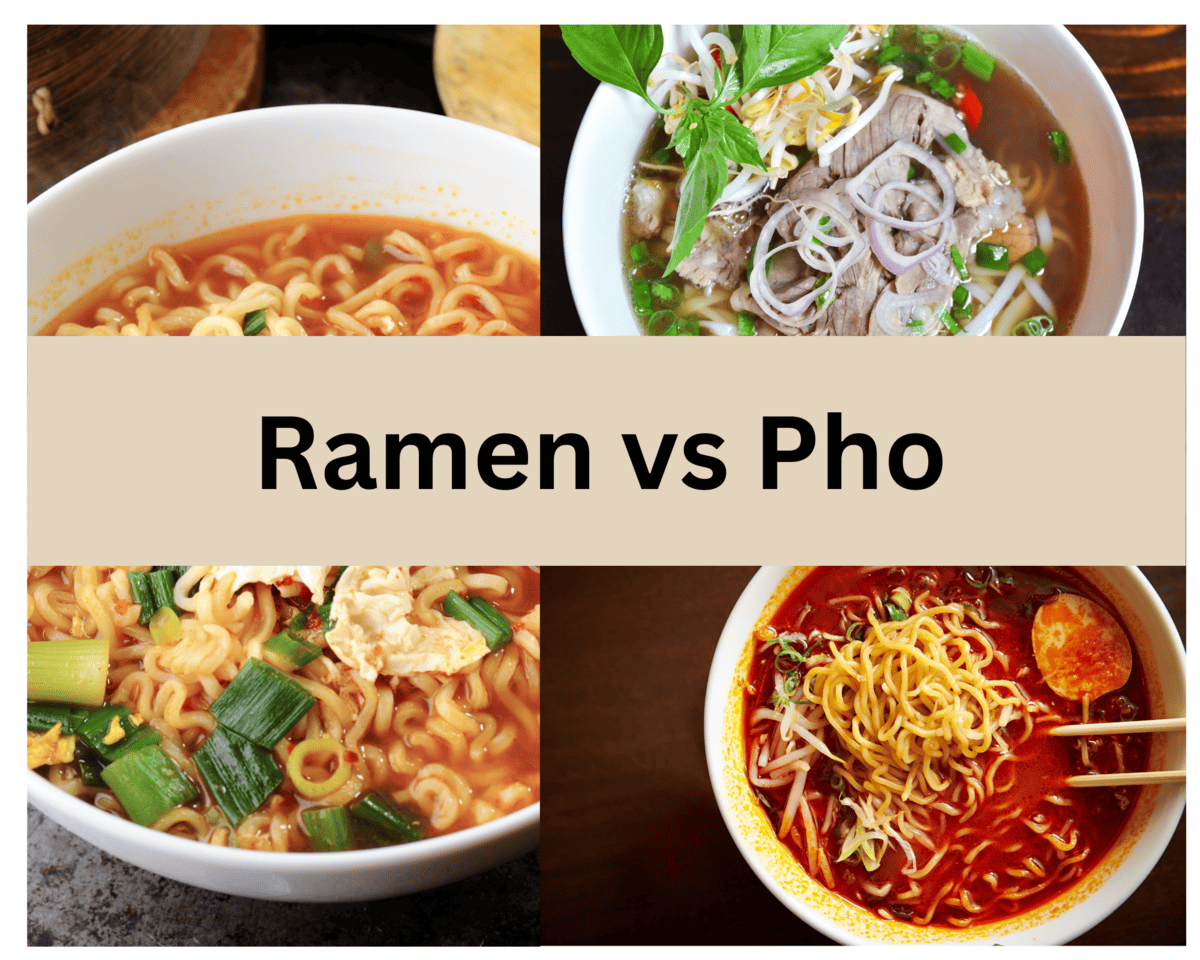
This image is property of drizzlemeskinny.com.
Pho and Matzo Ball Soup
Shifting our focus to another cultural juxtaposition, we compare pho with Matzo Ball soup, a Jewish delicacy often enjoyed during Passover and other special occasions. Contrasting the flavor and ingredients of these two soups reveals the distinct qualities that make each of them unique and cherished in their respective culinary traditions.
Introduction to Matzo Ball Soup – A Jewish delicacy
Matzo Ball soup is a cherished dish in Jewish cuisine, often regarded as a comfort food. It consists of a flavorful chicken broth and light, fluffy matzo balls, which are dumplings made from matzo meal (unleavened bread), eggs, and sometimes herbs. Matzo Ball soup is traditionally enjoyed during Passover and other Jewish holidays.
Contrasting Matzo Ball soup and Pho in terms of flavor and ingredients
Matzo Ball soup and pho differ significantly in flavor and ingredients. Matzo Ball soup features a chicken broth that is seasoned with carrots, onions, and sometimes dill. The matzo balls themselves are light and airy, imparting a subtle savory flavor to the soup.
On the other hand, pho boasts a complex and aromatic broth made from simmering beef bones, spices, and herbs. The combination of star anise, cinnamon, cloves, and ginger creates a unique blend of flavors that characterizes pho. The toppings such as thinly sliced beef or chicken, fresh herbs, bean sprouts, and lime elevate the taste profile of pho, offering a robust and refreshing experience.
Matzo Ball soup and pho represent the distinct culinary traditions and cultural identities of their respective communities. Each soup showcases the artistry and creativity of its culinary heritage, offering a delightful and comforting experience that resonates with those who appreciate either Jewish or Vietnamese cuisine.
Pho vs Consommé
The comparison between pho and Consommé takes us to the realm of French cuisine, where consommé holds a significant place as a refined and elegant soup. Analyzing the contrasts between Consommé and pho’s cooking techniques, flavors, and ingredients reveals their unique approaches to soup-making.
Consommé in French Cuisine
Consommé, meaning “clarified” in French, is a clear and refined soup that showcases the pure essence of its ingredients. It is typically made by simmering a well-seasoned stock or broth with a mixture of ground meat, aromatics, and sometimes egg whites. This technique clarifies the soup, removing impurities and achieving a crystal-clear liquid.
Consommé is often served as a starter or palate cleanser in French cuisine, demonstrating the precision and attention to detail that is characteristic of this culinary tradition.
Analyzing the contrasts between Consommé and Pho’s cooking techniques
The cooking techniques employed in making consommé and pho differ significantly. Consommé requires a meticulous and precise process to achieve its clear and concentrated flavor. The broth is carefully simmered, allowing the impurities to rise to the surface. The mixture of ground meat and aromatics, known as a “raft,” is added to the broth, which absorbs the impurities, resulting in a clarified and intensely flavored consommé.
In contrast, pho broth is made by simmering beef bones, onions, ginger, and spices for an extended period, allowing the flavors to meld together and create a rich and aromatic broth. The slow and deliberate cooking process contributes to the deep and complex flavors that characterize pho.
Comparison of Consommé and Pho’s flavors and ingredients
Consommé is known for its delicate and refined flavors, highlighting the pure essence of the ingredients. The clarified broth showcases the quality and complexity of the stock, offering a clean and elegant taste.
Pho, on the other hand, boasts a more robust and aromatic flavor profile. The combination of beef bones, star anise, cinnamon, and other spices creates a harmonious blend of savory and fragrant notes. The inclusion of various toppings such as thinly sliced beef or chicken, fresh herbs, and lime adds further depth and complexity to the overall flavor of pho.
Consommé and pho exemplify the diverse approaches to soup-making in French and Vietnamese culinary traditions. While consommé focuses on achieving clarity and refinement, pho embraces bold and aromatic flavors, both showcasing the artistry and creativity of their respective cultures.
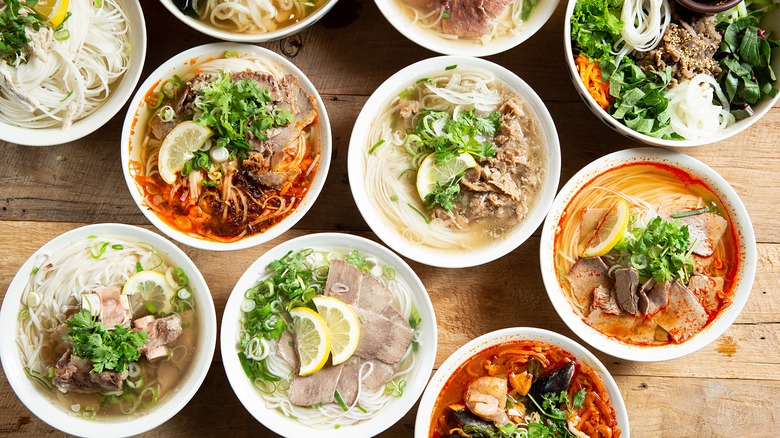
This image is property of www.foodrepublic.com.
Pho and Minestrone
The final comparison takes us to Italy, where we explore the composition and characteristics of Minestrone, a classic Italian soup. Comparing pho and Minestrone in terms of their composition, preparation, and ingredients allows us to appreciate the unique qualities that make each of them beloved in their culinary traditions.
The Italian classic Minestrone’s composition
Minestrone is a hearty and filling soup that exemplifies the rustic nature of Italian cuisine. It typically consists of a rich tomato-based broth, a variety of vegetables such as carrots, celery, potatoes, beans, and often includes pasta or rice. Minestrone is a versatile soup that can be customized according to seasonal ingredients, making it a true reflection of the flavors of Italy.
Comparative study of Pho and Minestrone preparation and ingredients
The preparations and ingredients used in pho and Minestrone differ significantly. Pho requires hours of slow simmering to extract the flavors from the bones and spices, resulting in a rich and aromatic broth. The emphasis in pho is on the carefully crafted and nuanced flavors of the broth, while the other ingredients enhance and complement the overall taste profile.
Minestrone, on the other hand, typically involves sautéing the vegetables in olive oil to develop their flavors before adding the broth and simmering. The tomato-based broth in Minestrone provides a robust and savory base for the soup, while the variety of vegetables and pasta or rice contribute to its heartiness.
Contrasting Pho and Minestrone in terms of taste
Pho and Minestrone offer distinct taste experiences that reflect the cultural traditions of their respective regions. Pho boasts a delicate and aromatic flavor profile, with the savory broth serving as the backdrop for the other ingredients. The rice noodles and toppings add layers of texture and freshness, creating a delightful sensory experience.
Minestrone, on the other hand, showcases the earthy and comforting flavors of Italian cuisine. The combination of vegetables, tomatoes, and pasta or rice results in a hearty and satisfying soup that warms the soul. The use of olive oil and various herbs and seasonings adds depth and complexity to the overall taste.
Pho and Minestrone demonstrate the culinary diversity found across the globe. Each soup showcases the distinctive flavors and cultural influences that have made them beloved in their respective regions, offering a delightful and comforting experience for soup enthusiasts.
Pho and Gazpacho
Our final comparison takes us to Spain, where we explore the unique characteristics of Gazpacho, a chilled Spanish soup. Contrasting the temperature, ingredients, and texture of Gazpacho with pho provides a fascinating perspective on the diversity of soups across cultures.
Introduction to Gazpacho – The Spanish chilled soup
Gazpacho is a classic Spanish soup that is often enjoyed during hot summer months. It is traditionally made by blending tomatoes, cucumbers, bell peppers, onions, garlic, olive oil, and vinegar. Gazpacho is served chilled and offers a refreshing and vibrant taste that is synonymous with Mediterranean cuisine.
Contrasting Pho and Gazpacho in terms of temperature, ingredients, and texture
One of the most significant contrasts between pho and Gazpacho is in their temperature. Pho is a hot soup, typically enjoyed warm, offering nourishment and comfort, particularly during cooler months. Gazpacho, on the other hand, is consumed cold, making it a perfect choice for hot summer days. The chilled temperature of Gazpacho adds to its refreshing qualities and makes it an ideal dish to cool down with.
The ingredients used in pho and Gazpacho also differ vastly. Pho features a hearty beef or chicken broth, fragrant spices, and an array of fresh herbs, vegetables, and noodles. It showcases the rich culinary traditions of Vietnam. Gazpacho, on the other hand, is characterized by its vibrant colors and flavors, with the fresh ingredients giving it a light and tangy taste.
In terms of texture, pho offers a combination of the tender rice noodles, thinly sliced meats, and crisp bean sprouts that provide a delightful interplay of soft and crunchy textures. Gazpacho, being a liquid soup, offers a smooth and silky texture that is enhanced by the freshness of the blended ingredients.
Pho and Gazpacho exemplify the versatility and creativity found in global cuisine. The contrasting temperatures, ingredients, and textures reflect the unique culinary traditions and cultural influences that have made these soups beloved choices in their respective regions.
In conclusion, exploring the comparisons between pho and various other soups from around the world reveals the diversity and creativity found in global cuisine. Each soup represents its respective culture, showcasing unique flavors, ingredients, and preparations. From the aromatic and comforting pho of Vietnam to the spicy and tangy Tom Yum soup of Thailand, from the refined Consommé of French cuisine to the rustic Minestrone of Italy, each soup offers its own distinct qualities and culinary experiences. Whether you are craving a warm and comforting bowl of Chicken Noodle Soup or a refreshing chilled Gazpacho, these soups capture the essence of their respective cultures and reflect the rich tapestry of flavors found around the world. So, the next time you find yourself in the mood for soup, consider venturing beyond your comfort zone and exploring the wide world of soups that await you.

